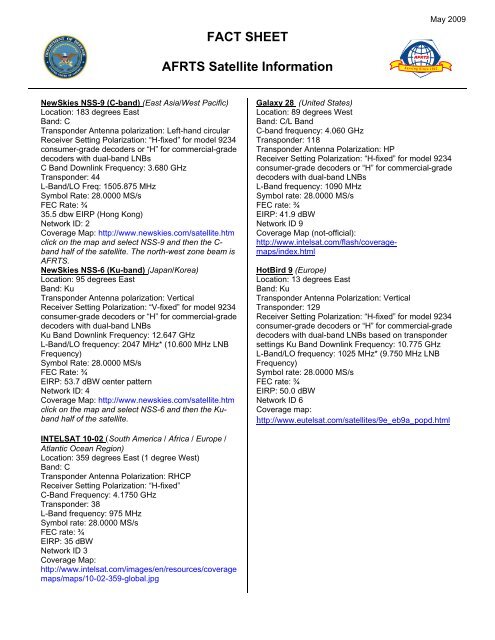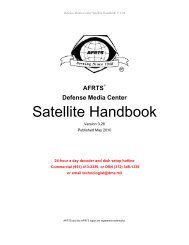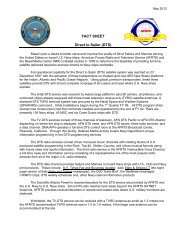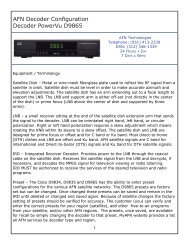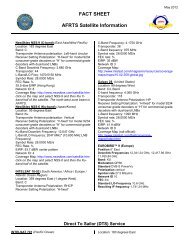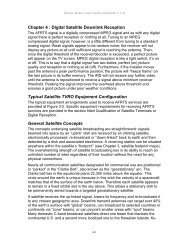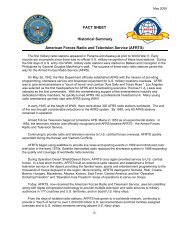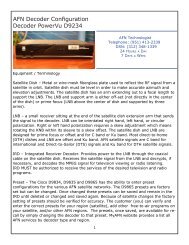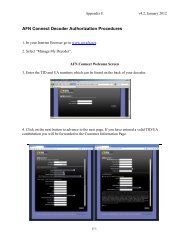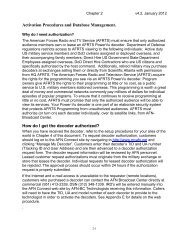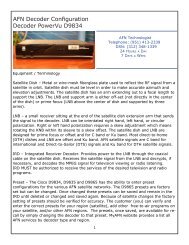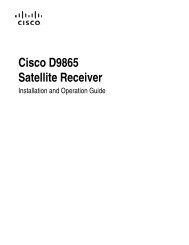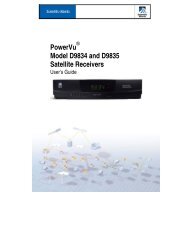FACT SHEET AFRTS Satellite Information
FACT SHEET AFRTS Satellite Information
FACT SHEET AFRTS Satellite Information
You also want an ePaper? Increase the reach of your titles
YUMPU automatically turns print PDFs into web optimized ePapers that Google loves.
NewSkies NSS-9 (C-band) (East Asia/West Pacific)<br />
Location: 183 degrees East<br />
Band: C<br />
Transponder Antenna polarization: Left-hand circular<br />
Receiver Setting Polarization: “H-fixed” for model 9234<br />
consumer-grade decoders or “H” for commercial-grade<br />
decoders with dual-band LNBs<br />
C Band Downlink Frequency: 3.680 GHz<br />
Transponder: 44<br />
L-Band/LO Freq: 1505.875 MHz<br />
Symbol Rate: 28.0000 MS/s<br />
FEC Rate: ¾<br />
35.5 dbw EIRP (Hong Kong)<br />
Network ID: 2<br />
Coverage Map: http://www.newskies.com/satellite.htm<br />
click on the map and select NSS-9 and then the Cband<br />
half of the satellite. The north-west zone beam is<br />
<strong>AFRTS</strong>.<br />
NewSkies NSS-6 (Ku-band) (Japan/Korea)<br />
Location: 95 degrees East<br />
Band: Ku<br />
Transponder Antenna polarization: Vertical<br />
Receiver Setting Polarization: “V-fixed” for model 9234<br />
consumer-grade decoders or “H” for commercial-grade<br />
decoders with dual-band LNBs<br />
Ku Band Downlink Frequency: 12.647 GHz<br />
L-Band/LO frequency: 2047 MHz* (10.600 MHz LNB<br />
Frequency)<br />
Symbol Rate: 28.0000 MS/s<br />
FEC Rate: ¾<br />
EIRP: 53.7 dBW center pattern<br />
Network ID: 4<br />
Coverage Map: http://www.newskies.com/satellite.htm<br />
click on the map and select NSS-6 and then the Kuband<br />
half of the satellite.<br />
INTELSAT 10-02 (South America / Africa / Europe /<br />
Atlantic Ocean Region)<br />
Location: 359 degrees East (1 degree West)<br />
Band: C<br />
Transponder Antenna Polarization: RHCP<br />
Receiver Setting Polarization: “H-fixed”<br />
C-Band Frequency: 4.1750 GHz<br />
Transponder: 38<br />
L-Band frequency: 975 MHz<br />
Symbol rate: 28.0000 MS/s<br />
FEC rate: ¾<br />
EIRP: 35 dBW<br />
Network ID 3<br />
Coverage Map:<br />
http://www.intelsat.com/images/en/resources/coverage<br />
maps/maps/10-02-359-global.jpg<br />
<strong>FACT</strong> <strong>SHEET</strong><br />
<strong>AFRTS</strong> <strong>Satellite</strong> <strong>Information</strong><br />
S e r v i n g Since 1942<br />
May 2009<br />
Galaxy 28 (United States)<br />
Location: 89 degrees West<br />
Band: C/L Band<br />
C-band frequency: 4.060 GHz<br />
Transponder: 118<br />
Transponder Antenna Polarization: HP<br />
Receiver Setting Polarization: “H-fixed” for model 9234<br />
consumer-grade decoders or “H” for commercial-grade<br />
decoders with dual-band LNBs<br />
L-Band frequency: 1090 MHz<br />
Symbol rate: 28.0000 MS/s<br />
FEC rate: ¾<br />
EIRP: 41.9 dBW<br />
Network ID 9<br />
Coverage Map (not-official):<br />
http://www.intelsat.com/flash/coveragemaps/index.html<br />
HotBird 9 (Europe)<br />
Location: 13 degrees East<br />
Band: Ku<br />
Transponder Antenna Polarization: Vertical<br />
Transponder: 129<br />
Receiver Setting Polarization: “H-fixed” for model 9234<br />
consumer-grade decoders or “H” for commercial-grade<br />
decoders with dual-band LNBs based on transponder<br />
settings Ku Band Downlink Frequency: 10.775 GHz<br />
L-Band/LO frequency: 1025 MHz* (9.750 MHz LNB<br />
Frequency)<br />
Symbol rate: 28.0000 MS/s<br />
FEC rate: ¾<br />
EIRP: 50.0 dBW<br />
Network ID 6<br />
Coverage map:<br />
http://www.eutelsat.com/satellites/9e_eb9a_popd.html
INTELSAT 701 (Pacific Ocean)<br />
Location: 180 degrees East<br />
Band: C<br />
Transponder Antenna Polarization: LHCP<br />
Receiver Setting Polarization: “H-fixed”<br />
C-Band frequency: 4.1735 GHz<br />
L-Band frequency: 976.5 MHz<br />
Symbol Rate: 3.6800 MS/s<br />
FEC rate: 2/3<br />
EIRP: 29.0 dBW<br />
Network ID 5<br />
Coverage map:<br />
http://www.intelsat.com/images/en/resources/coveragema<br />
ps/maps/701-180-global.jpg (global)<br />
INTELSAT 906 (Indian Ocean and Persian Gulf)<br />
Location: 64.1 degrees East<br />
Band: C<br />
Transponder Antenna Polarization: LHCP<br />
Receiver Setting Polarization: “H-fixed”<br />
C-Band frequency: 4093.5 MHz<br />
L-Band frequency: 1056.5 MHz<br />
Symbol Rate: 3.6800 MS/s<br />
FEC Rate: 2/3<br />
EIRP: 29.0 dBW<br />
Network ID 7<br />
Coverage map:<br />
http://www.intelsat.com/images/en/resources/coveragema<br />
ps/maps/906-64-global.jpg (global)<br />
Direct To Sailor (DTS) Service<br />
May 2009<br />
New Skies NSS-7<br />
(Atlantic Ocean and Mediterranean Sea)<br />
Location: 338.0 degrees East (22 degrees West)<br />
Band: C<br />
Transponder Antenna Polarization: LHCP<br />
Receiver Setting Polarization: “H-fixed”<br />
C-Band frequency: 4115 MHz<br />
L-Band frequency: 1035 MHz<br />
Symbol Rate: 3.6800 MS/s<br />
FEC Rate: 2/3<br />
EIRP: 30.5 dBW<br />
Network ID 6<br />
Coverage map: http://www.newskies.com/satellite.htm<br />
(global)<br />
AMC-1 Ku Band (The Pentagon Channel)<br />
Location: 103 degrees West<br />
Band: Ku<br />
Transponder 20 Polarity: Vertical<br />
Receiver Setting Polarization: Vertical<br />
Ku band frequency: 12.100 GHz*<br />
Symbol Rate: 20,000 MS/s<br />
FEC Rate: ¾<br />
Encryption: none<br />
Coverage map:<br />
http://www.ses-americom.com/americom_2008/siteSections/technical/satelliteFleet/amc1/index.php<br />
*Important note on LNB frequencies:<br />
All C-band LNB’s have a local oscillator (L.O.) frequency of 5.150 GHz but Ku-band LNB’s may come in many different<br />
frequencies typically 9.750 to 12.75 GHz. This means that if you’re attempting to watch a Ku-band service you need to set<br />
the decoder’s frequency using a bit of simple math. The formula to set the Ku-Low/Single L.O. frequency on the <strong>AFRTS</strong><br />
decoder is the downlink frequency minus the L.O. frequency. As an example the downlink frequency for the INTELSAT<br />
804 satellite serving the Japan and Korea Direct to Home service area is 11.6380 GHz. An LNB with a local oscillator<br />
frequency of 10.000 GHz would give a Ku Low/Single L.O. frequency of 1638 MHz (1.638 GHz) by working the math<br />
problem 11.16380 – 10.000 = 1.638. The Ku-band satellite serving the European service area is HotBird 4 at 13 degrees<br />
east and it has a downlink frequency of 10.775 GHz. Connecting an LNB with a local oscillator frequency of 9.750 would<br />
result in a receiver frequency of 1025 MHz (10.775 – 9.750 = 1.025 GHz which is 1025 MHz). Source:<br />
http://afrts.dma.mil/tech_info/page.asp?pg=tech_info


